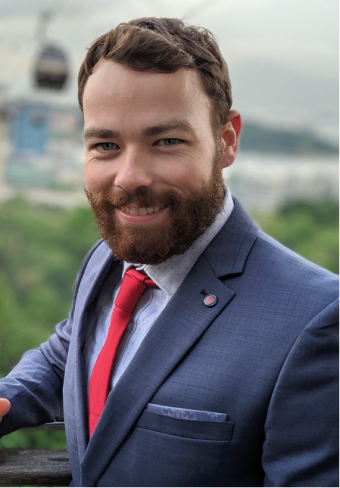
Date:
Location:
Title:
ABSTRACT
The McCormack lab has been focusing on understanding thermochemical and thermophysical properties of refractory materials that can operate in extreme environments. From this, I would like to present two key stories: (i) construction of the HfO2-Ta2O5 phase diagram up to 3000 ˚C and (ii) the thermal expansion of metal diborides up to 3050 ˚C.
In-situ phase diagram elucidation of the HfO2-Ta2O5 system up to 3000˚C
Scott J. McCormack, Ben Hulbert, Kuo-ping Tseng, Richard Weber, Denys Kapush, Sergey Ushakov, Alexandra Navrostky and Waltraud M. Kriven
Ceramic equilibrium phase diagrams have proven to be difficult to produce for materials above 1500 ˚C. We demonstrate that in-situ X-ray powder diffraction on laser-heated, levitated samples can be used to elucidate phase diagrams up to 3000 ˚C. In these experiments, solid spherical samples were suspended and rotated by a gas stream through a conical nozzle levitator, heated by a 400 W CO2 laser at beamline 6-ID-D of the Advanced Photon Source at Argonne National Laboratory, Lemont, IL, USA. X-ray diffraction patterns were collected at 100 ˚C temperature intervals and were used to determine the phase fields of phases present. Unknown crystal structures were solved using the charge flipping method. Observed phase transformations were examined using symmetry decomposition. The liquidus temperatures were determined from laser heated recoalescence experiments. The solidification pathways were determined based on the observed melting temperature and phases observed just prior to melting. The exact ternary eutectic and peritectic compositions still need to be verified. The HfO2-Ta2O5 binary was investigated as an example system due to its high melting points and application in refractories and electronics. The next step is to use CALPHAD to combine the data collected in this study with enthalpies of formation measured via calorimetry to map out the phase space more accurately.
Thermal expansion of metal diborides (MB2 | M = Ti, Zr, Nb, Hf, Ta) up to 3050˚C
Elizabeth Sobalvarro, Fox Thorpe, Jesus Rivera, Harry Charalambous, Gabriella King, James Cahill, Wyatt L. Du Frane, Joshua D. Kuntz and Scott J. McCormack
Metal diborides (MB2 | M = Ti, Zr, Nb, Hf, Ta) are considered an ultra-high temperature refractory ceramic due to their relatively low reactivity and high melting point. While these properties are appealing, they also make it difficult to fully characterize their thermochemical and thermophysical properties up to melting. This work will discuss in-situ high temperature X-ray diffraction measurements up to ~3050 ˚C using a conical nozzle levitator system equipped with a 400 W CO2 laser. The high temperature X-ray diffraction data was used to calculate anisotropic coefficients of thermal expansion. The coefficients were compared amongst the five diborides (MB2 | M = Ti, Zr, Nb, Hf, Ta). It was found that the anisotropy could be related to the atomic displacement parameters of the metal cations. These thermophysical measurements will be critical in developing ultra-high temperature material systems for applications in hypersonic vehicles, nuclear fission/fusion reactors, and spacecraft.
This work was performed under the auspices of the U.S. Department of Energy by Lawrence Livermore National Laboratory under contract DE-AC52-07NA27344. Lawrence Livermore National Security, LLC. LLNL-ABS-836360
BIO
Scott J. McCormack grew up in the small fishing village of Eden on the Far South Coast of Australia. He completed a Bachelor of Engineering with First Class Honors (H1), majoring in Materials Engineering at the University of Wollongong, NSW, Australia in 2013. He then completed his Ph.D. in Materials Science and Engineering from the University of Illinois at Urbana-Champaign, IL, USA in 2019. He is now an Assistant Professor of Materials Science and Engineering at the University of California, Davis, USA. He was a recipient of National Science Foundation (NSF) Early Career Award in 2021. His research focuses on the interplay of crystal symmetry and energetic stability of materials in extreme environments (ultra-high temperature) for applications in hypersonic platforms, nuclear fission/fusion and space exploration.
Hosted by Carlos G. Levi. Download event flyer.



